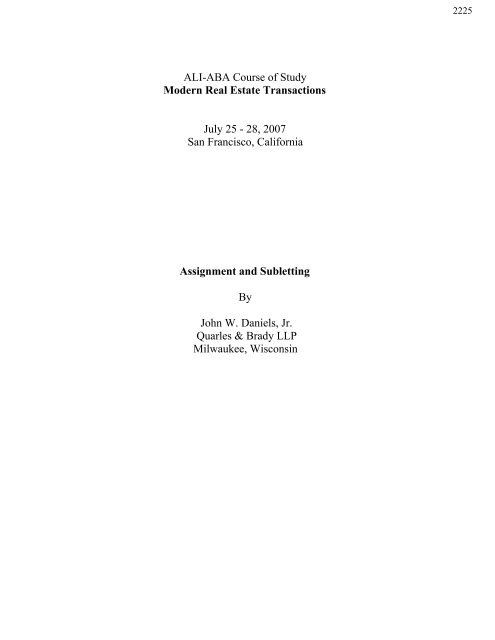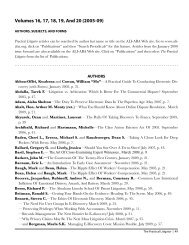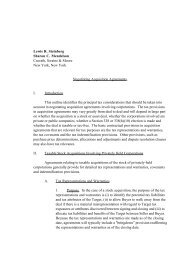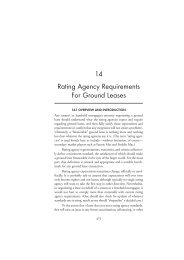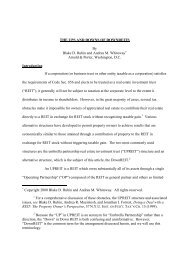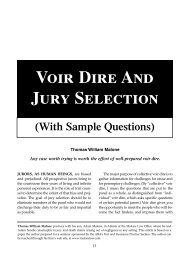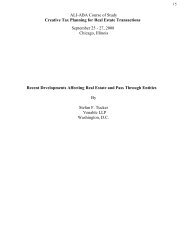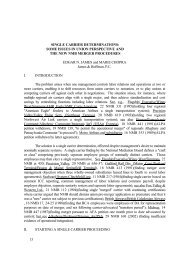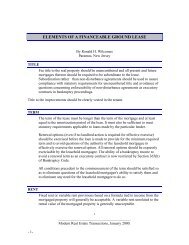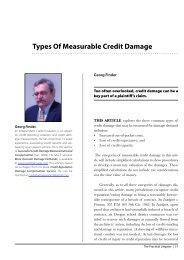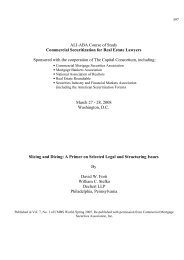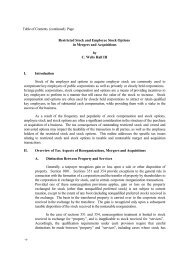ALI-ABA Course of Study Modern Real Estate Transactions July 25 ...
ALI-ABA Course of Study Modern Real Estate Transactions July 25 ...
ALI-ABA Course of Study Modern Real Estate Transactions July 25 ...
Create successful ePaper yourself
Turn your PDF publications into a flip-book with our unique Google optimized e-Paper software.
22<strong>25</strong><br />
<strong>ALI</strong>-<strong>ABA</strong> <strong>Course</strong> <strong>of</strong> <strong>Study</strong><br />
<strong>Modern</strong> <strong>Real</strong> <strong>Estate</strong> <strong>Transactions</strong><br />
<strong>July</strong> <strong>25</strong> - 28, 2007<br />
San Francisco, California<br />
Assignment and Subletting<br />
By<br />
John W. Daniels, Jr.<br />
Quarles & Brady LLP<br />
Milwaukee, Wisconsin
2226<br />
2
2227<br />
ASSIGNMENT AND SUBLETTING<br />
John W. Daniels, Jr. 1<br />
I. GENERAL PRINCIPLES AND MATTERS.<br />
Quarles & Brady LLP<br />
Milwaukee, Wisconsin<br />
A. Business and Practical Aspects <strong>of</strong> Tenant’s Right to Assign and Sublet. 1 MILTON<br />
R. FRIEDMAN, FRIEDMAN ON LEASES § 7.1 (4th ed. 1997 & Supp. 2002). A<br />
Tenant should understand that it assumes significant liabilities when it enters into<br />
a lease and should presume that it will be responsible for performance under the<br />
lease for the entire length <strong>of</strong> the term. As a practical matter, the right to assign or<br />
sublease its interest may be <strong>of</strong> vital importance to a Tenant, who may otherwise<br />
be obligated to pay rent and maintenance costs, as well as perform other duties,<br />
for property <strong>of</strong> no economic value to the Tenant; in many cases, a Landlord does<br />
not need to find a replacement Tenant, should the original Tenant quit the<br />
premises prior to the expiration <strong>of</strong> the lease’s term.<br />
B. Definition and Effects <strong>of</strong> Operative Terms. 49 AM. JUR. 2d Landlord and Tenant<br />
§ 1076 (1995 & Supp. 2002); RAYMOND J. WERNER AND ROBERT KRATOVIL,<br />
REAL ESTATE LAW (10th ed. 1993).<br />
1. Assignment. An assignment is a transfer <strong>of</strong> the entire leasehold interest in<br />
all or a part <strong>of</strong> the demised premises for the unexpired term <strong>of</strong> the original<br />
lease. See New Amsterdam Casualty Co. v. Nat’l Union Fire Ins. Co. <strong>of</strong><br />
Pittsburgh, Pa., 266 N.Y. <strong>25</strong>4, 194 N.E. 745 (1935); Waller v. Comm’r <strong>of</strong><br />
Internal Revenue, 40 F.2d 892 (5th Cir. 1930).<br />
2. Subleasing. A sublease is a transfer <strong>of</strong> only a part <strong>of</strong> the leasehold; the<br />
sublessor retains a reversion (even if only minimal). See Marcelle, Inc. v.<br />
Sol & S. Marcus Co., 274 Mass. 469, 175 N.E. 83 (1931); Coles Trading<br />
Co. v. Spiegel, Inc., 187 F.2d 984 (9th Cir. 1951).<br />
3. Common Law on the Right to Assign. MacFadden-Deauville Hotel,<br />
Inc. v. Murrell, 182 F.2d 537 (5th Cir. 1950); Valley Oil Co. v. Barberian,<br />
344 Mass. 759, 183 N.E.2d 109 (1962); Presby v. Benjamin, 169 N.Y.<br />
377, 380, 62 N.E. 430, 431 (1902); 2 RICHARD POWELL AND ROY BELDEN,<br />
LAW OF REAL PROPERTY § 17.04 (2003); 1 AMERICAN LAW OF PROPERTY<br />
§ 3.75 (1952 & Supp. 1980); Annotation, Right <strong>of</strong> Lessee in Absence <strong>of</strong><br />
Covenant to Assign Lease or Sublet Premises, 70 A.L.R. 486 (1931); 51C<br />
C.J.S. Landlord and Tenant § 31 (1968 & Supp. 2002); 49 AM. JUR. 2d<br />
Landlord and Tenant § 1082 (1995 & Supp. 2002); ROBERT S.<br />
1 This outline was prepared with the assistance <strong>of</strong> Shawn D. Gould (Boalt Hall 2001), an associate in the <strong>Real</strong> <strong>Estate</strong><br />
Practice Group <strong>of</strong> the firm.<br />
QBMKE\5419766.5
2228<br />
SCHOSHINSKI, AMERICAN LAW OF LANDLORD AND TENANT § 8:10 (1980 &<br />
Supp. 2003).<br />
i. Absent express restriction, general rule allows assignment or<br />
subletting (even where lease contains percentage rent provision).<br />
49 Am. Jur. 2d Landlord and Tenant § 1082 (1995 & Supp. 2002);<br />
Crestwood Plaza, Inc. v. Kroger Co., 520 S.W.2d 93 (Mo. App.<br />
1974); Rowe v. Great Atl. & Pac. Tea Co., 61 A.D.2d 473, 402<br />
N.Y.S.2d 593 (App. Div. 1978), rev’d, 412 N.Y.S.2d 827, 385<br />
N.E.2d 566 (1978).<br />
ii.<br />
Exceptions (farm lease, tenancy-at-will).<br />
4. Assignment and Sublease Distinguished. 49 AM. JUR. 2d Landlord and<br />
Tenant § 1077 (1995 & Supp. 2002); 1 HERBERT TIFFANY, REAL<br />
PROPERTY § 123 (3d ed. 1939); Wallace, Assignment and Sublease, 8 IND.<br />
L.J. 359 (1939); 51C C.J.S. Landlord and Tenant §§ 37, 43 (1968 & Supp.<br />
2002); ROBERT S. SCHOSHINSKI, AMERICAN LAW OF LANDLORD AND<br />
TENANT, § 8:10 (1980 & Supp. 2003); 1 MILTON R. FRIEDMAN,<br />
FRIEDMAN ON LEASES, § 7.401 n.1; Joseph Oros. Co. v. F.W. Woolworth<br />
Co., 844 F.2d 369 (6th Cir. 1988) (under Ohio law, a transfer <strong>of</strong> a<br />
leasehold for a period one day less than the term <strong>of</strong> the main lease is a<br />
sublease and not an assignment); Tidewater Investors Ltd. v. United<br />
Dominion <strong>Real</strong>ty Trust, Inc., 804 F.2d 293 (4th Cir. 1986) (Virginia law);<br />
In re Miami Dyeing & Printing, Inc., 14 B.R. 947 (S.D. Fla. 1981);<br />
Walgreen Arizona Drug Co. v. Plaza Ctr. Corp., 132 Ariz. 512, 647 P.2d<br />
643 (Ct. App. 1982); Rocklen, Inc. v. Radulesco, 10 Conn. App. 271, 522<br />
A.2d 846 (1987); Dayenian v. Am. Nat'l Bank & Trust Co., 91 Ill. App. 3d<br />
622, 414 N.E.2d 1199 (1980); Italian Fisherman, Inc. v. Middlemas, 313<br />
Md. 156, 545 A.2d 1 (1988); Hardle v. Preston Energy, Inc., 374 N.W.2d<br />
807 (Minn. Ct. App. 1985); Weeks v. Cal-Maine Foods, Inc., 522 So. 2d<br />
7<strong>25</strong> (Miss. 1987); Capoccia v. Brognano, 135 A.D. 2d 1010, 522<br />
N.Y.S.2d 733 (1987), appeal dismissed (N.Y. App. Div. 1987), 71 N.Y.2d<br />
1022, 526 N.E.2d 48, 530 N.Y.S.2d 557 (1988); McSpadden v. Dawson,<br />
117 A.D.2d 453, 503 N.Y.S.2d 357 (1986); Bostonian Shoe Co. v.<br />
Wulwick Assocs., 119 A.D.2d 717, 501 N.Y.S.2d 393 (1986), appeal<br />
dismissed; Conklin Dev. Corp. v. Acme Mkts., Inc., 89 A.D.2d 769, 453<br />
N.Y.S.2d 930 (1982), appeal dismissed, 58 N.Y.2d 929, 460 N.Y.S.2d<br />
532, 447 N.E.2d 80 (1983); Anchor Holding Co. v. Michael's C<strong>of</strong>fee Shop,<br />
81 A.D.2d 535, 438 N.Y.S.2d 104 (1981); Krasner v. Transcon. Equities,<br />
Inc., 70 A.D.2d 312, 420 N.Y.S.2d 872 (1979); Neal v. Craig Brown, Inc.,<br />
86 N.C. App. 157, 356 S.E.2d 912 (1987), review denied, 320 N.C. 794,<br />
361 S.E.2d 80 (1987); Castle v. Double Time, Inc., 737 P.2d 900 (Okla.<br />
1986); Parr v. Farmers State Bank, 659 S.W.2d 883 (Tex. App. 1983); L<br />
& M Corp. v. Loader, 688 P.2d 448 (Utah 1984); <strong>Estate</strong> <strong>of</strong> Whitley v.<br />
Anning, 392 So. 2d 799 (La. Ct. App. 1980); Chemical Dynamics, Inc. v.<br />
Newfeld, 728 S.W.2d 590 (Mo. Ct. App. 1987); Joseph Bros. Co. v. F.W.<br />
QBMKE\5419766.5 2
2229<br />
Woolworth Co., 844 F.2d 369 (6th Cir. 1988); F.W. Woolworth Co. v.<br />
Plaza North, Inc., 493 N.E.2d 1304 (Ind. Ct. App. 1986); Maxima Corp. v.<br />
Cystic Fibrosis Found., 81 Md. App. 602, 568 A.2d 1170 (1990);<br />
Northside Station Assocs. P’ship v. Maddry, 105 N.C. App. 384, 413<br />
S.E.2d 319 (1992); Burgess Pic-Pac, Inc. v. Fleming Cos., Inc., 190 W.<br />
Va. 169, 437 S.E.2d 742 (1993); Lamonts Apparel, Inc. v. Si-Lloyd<br />
Assocs., 157 Or. App. 44, 967 P.2d 905 (1998).<br />
i. Privity <strong>of</strong> contract ("POC") and privity <strong>of</strong> estate ("POE"). First<br />
Am. Nat'l Bank v. Chicken Sys. <strong>of</strong> Am., Inc., 616 S.W.2d 156<br />
(Tenn. Ct. App. 1980); L & M Corp. v. Loader, 688 P.2d 448<br />
(Utah 1984) (assignor could not sue Landlord for breach <strong>of</strong> right <strong>of</strong><br />
first refusal because right was transferred to assignee by<br />
assignment <strong>of</strong> lease); OTR v. Flakey Jake's, Inc., 112 Wash. 2d<br />
243, 710 P.2d 629 (1989); Satellite Gateway Communications, Inc.<br />
v. Musi Dining Car Co., 110 N.J. 280, 540 A.2d 1267 (1988)<br />
(attorney fees relative to default); North Bergen Rex Transp., Inc.<br />
v. Trailer Leasing Co., 158 N.J. 561, 730 A.2d 843 (1999); Cmty.<br />
<strong>Real</strong>ty Mgmt., Inc. v. Harris, 155 N.J. 212, 714 A.2d 282 (1998).<br />
(a)<br />
(b)<br />
Matters prior or subsequent to transfer not covered by POE.<br />
POE affects matters "running with land."<br />
ii.<br />
iii.<br />
iv.<br />
Reservations <strong>of</strong> time, rent, re-entry, etc. 1 MILTON R. FRIEDMAN,<br />
FRIEDMAN ON LEASES § 7.403a (4th ed. 1997 & Supp. 2002).<br />
Majority rule. This is also called the “English Rule” and states that<br />
an assignment, rather than a sublease, exists only if the transfer <strong>of</strong><br />
the leasehold interest is complete and the transferee does not retain<br />
a reversion. See 1 MILTON R. FRIEDMAN, FRIEDMAN ON LEASES §<br />
7.403a (4th ed. 1997 & Supp. 2002); Davidson v. Minn. Loan &<br />
Trust Co., 158 Minn. 411, 197 N.W. 833 (1924);<br />
Minority rule. Courts adopting this view look at the intent <strong>of</strong> the<br />
parties to determine whether the transfer <strong>of</strong> the leasehold interest is<br />
an assignment or a sublease. See Jaber v. Miller, 219 Ark. 59, 239<br />
S.W.2d 760 (1951); Ernst v. Conditt, 54 Tenn. App. 328, 390<br />
S.W.2d (1965); but see Northside Station Assocs. P’ship v.<br />
Maddry, 105 N.C. App. 384, 413 S.E.2d 319 (1992).<br />
C. Lessor Assignment. A number <strong>of</strong> states have statutes permitting a Landlord to<br />
transfer its interest in the leased premises without the consent <strong>of</strong> the Tenant, as<br />
long as the lease itself does not expressly prohibit such transfer. See<br />
RESTATEMENT (SECOND) OF PROPERTY, § 15.1 stat. n. 3 (1977 & Supp. 2003).<br />
D. Statute <strong>of</strong> Frauds and Other Requisites. 49 AM. JUR. 2d Landlord and Tenant §§<br />
1086-1087 (1995 & Supp. 2002).<br />
QBMKE\5419766.5 3
2230<br />
II.<br />
APPLICABILITY OF RESTRICTIONS ON ASSIGNMENT AND SUBLEASING.<br />
A. Statutory, Tenancy-at-Will, Concessions. RESTATEMENT (SECOND) OF PROPERTY,<br />
§ 15.2 (1977 & Supp. 2003); 1 MILTON R. FRIEDMAN, FRIEDMAN ON LEASES §§<br />
7.301-7.302 (4th ed. 1997 & Supp. 2002).<br />
B. Standard <strong>of</strong> Strict Construction. 49 AM. JUR. 2d Landlord and Tenant §§ 1088,<br />
1090, 1092, 1093 (1995 & Supp. 2002); 1 MILTON R. FRIEDMAN, FRIEDMAN ON<br />
LEASES § 7.303 (4th ed. 1997 & Supp. 2002).<br />
1. Limited to the Category Described (i.e. merely stating that assignments<br />
are prohibited may not prohibit subleases).<br />
2. Prime Lease Limitation Effect On Sublease. 49 AM. JUR. 2d Landlord<br />
and Tenant § 1157 (1995 & Supp. 2002).<br />
3. For Benefit <strong>of</strong> Lessor. 49 AM. JUR. 2d Landlord and Tenant § 1148 (1995<br />
& Supp. 2002).<br />
i. Transfer in violation not void but voidable.<br />
ii.<br />
Transferee has "limited" right to raise breach as defense.<br />
4. Part or Whole. 49 AM. JUR. 2d Landlord and Tenant § 1166 (1995 &<br />
Supp. 2002).<br />
C. Express Restrictions. Courts generally look with disfavor on non-assignment<br />
clauses and strictly construe them against the Landlord, because they are viewed<br />
as restraints on the free alienation <strong>of</strong> property. See ROBERT S. SCHOSHINSKI,<br />
AMERICAN LAW OF LANDLORD AND TENANT § 8:16, 583 (1980 & Supp. 2003); 1<br />
AMERICAN LAW OF PROPERTY, § 358 (1952 & Supp. 1977). The Restatement<br />
would propose that a restraint on the alienation <strong>of</strong> either the Tenant’s or the<br />
Landlord’s interest without the consent <strong>of</strong> the other party be valid, but that the<br />
other party’s consent may not be unreasonably withheld unless a “freely<br />
negotiated provision in the lease” gives the other party the absolute right to<br />
withhold consent. See RESTATEMENT (SECOND) OF PROPERTY § 15.2 (1977 &<br />
Supp. 2003); see also Paul J. Weddle, Pacific First Bank v. New Morgan Park<br />
Corporation: Reasonable Withholding <strong>of</strong> Consent to Commercial Lease<br />
Assignments, 31 WILLAMETTE L. REV. 713 (1995); Martha Wach, Withholding<br />
Consent to Alienate: If Your Landlord is in a Bad Mood, Can He Prevent You<br />
From Alienating Your Lease, 43 DUKE L.J. 671 (1993); Todres and Lerner,<br />
Assignment and Subletting <strong>of</strong> Leased Premises: The Unreasonable Withholding <strong>of</strong><br />
Consent, 5 FORDHAM URB. L.J. 195 (1977); Annotation, When Lessor May<br />
Withhold Consent Under Unqualified Provision in Lease Prohibiting Assignment<br />
or Subletting <strong>of</strong> Leased Premises Without Lessor's Consent, 21 A.L.R. 4th 188<br />
(1983 & Supp. 2002); 49 AM. JUR. 2d Landlord and Tenant § 1090 (1995 &<br />
Supp. 2002); Effect <strong>of</strong> Leasehold Provisions Requiring the Lessor's Consent to<br />
QBMKE\5419766.5 4
2231<br />
Assignment, 21 HASTINGS L.J. 516 (1970); 1 MILTON R. FRIEDMAN, FRIEDMAN ON<br />
LEASES, § 7.303 (4th ed. 1997 & Supp. 2002).<br />
1. Absolute Restriction (i.e. no mention <strong>of</strong> Landlord’s consent): e.g.<br />
“Tenant shall not assign or sublet its interest under this Lease.”<br />
2. Assignment with Consent <strong>of</strong> Landlord: e.g. “Tenant shall not assign or<br />
sublet its interest under this Lease without Landlord’s prior written<br />
approval.” See Effect <strong>of</strong> Leasehold Provisions Requiring the Lessor's<br />
Consent to Assignment, 21 HASTINGS L.J. 516 (1970); Annotation, 54<br />
A.L.R. 3d 679 (1973 & Supp. 2002). There is a great deal <strong>of</strong> variance in<br />
the application <strong>of</strong> the consent standard, but the “majority” rule is that, if<br />
the lease is silent, the Landlord need not be reasonable in withholding its<br />
consent. See 421 Willow Corp. v. Callowhill Center Assocs., 2003 WL<br />
21361362 (Pa. Com. Pl. 2003) (holding that Pennsylvania follows the<br />
majority rule and that no requirement <strong>of</strong> acting reasonably will be imposed<br />
upon Landlord’s right to consent to assignments); but see Morgan<br />
Products, Ltd. v. Park Plaza <strong>of</strong> Oshkosh, Inc., 229 Wis.2d 231, 598<br />
N.W.2d 626 (1999) (holding that Landlord must be reasonable in refusing<br />
consent, but that Tenant bears the burden <strong>of</strong> proving Landlord’s<br />
unreasonableness); Carey v. Lincoln Loan Co., 165 Or. App. 657, 998<br />
P.2d 724 (2000) (holding that the phrase “which consent shall not be<br />
unreasonably withheld” is engrafted onto clauses merely stating that<br />
Tenant may not assign with Landlord’s consent). For other cases<br />
addressing this issue, see the following: Manley v. Kellar, 47 Del. 511, 94<br />
A.2d 219 (1952); Trusghinger v. Pak, 513 So. 2d 1151 (La. Ct. App.<br />
1987); Lilawanti Enter., Inc. v. Walden Book Co., 670 So. 2d 588 (La. Ct.<br />
App. 1996); 68 Beacon Street, Inc. v. Sohier, 289 Mass. 354, 194 N.E. 303<br />
(1935); Gruman v. Investors Diversified Serv. Inc., 247 Minn. 502, 78<br />
N.W.2d 377 (1956); Segre v. Ring, 103 N.H. 278, 170 A.2d 265 (1961);<br />
Mann Theatres Corp. v. Mid-Island Shopping Plaza Co., 94 A.D.2d 466,<br />
464 N.Y.S.2d 793 (1983); Ithaca Assocs. Co. v. Plataniotis, 274 A.D.2d<br />
640, 710 N.Y.S.2d 688 (2000); Isbey v. Crews, 55 N.C. App. 47, 284<br />
S.E.2d 534 (1981); Slavin v. Rent Control Bd. <strong>of</strong> Brookline, 406 Mass.<br />
458, 548 N.E.2d 1226 (1990); Dobyns v. South Carolina Dep’t <strong>of</strong> Parks,<br />
Recreation & Tourism, 317 S.C. 353, 454 S.E.2d 374 (Ct. App. 1995);<br />
Snortland v. Larson, 364 N.W.2d 67 (N.D. 1985) (applying Minnesota<br />
law); F & L Ctr. Co. v. Cunningham Drug Stores, Inc., 19 Ohio App. 3d<br />
72, 19 Ohio B.R. 156, 482 N.E.2d 1296 (1984); Shoney’s, Inc. v. Winthan<br />
Prop., 2001 Ohio 3965 (Ct. App. 2001); Reynolds v. McCullough, 739<br />
S.W.2d 424 (Tex. Ct. App. 1987) (writ denied); 718 Assocs., Ltd. v.<br />
Sunwest N.O.P., 1 S.W.3d 355 (Tex. Ct. App. 1999); Trinity Pr<strong>of</strong>’l Plaza<br />
Assocs. v. Metrocrest Hosp. Auth., 987 S.W.2d 621 (Tex. Ct. App. 1999);<br />
Twelve Oaks Tower I, Ltd. v. Premier Allergy, Inc., 938 S.W.2d 102 (Tex.<br />
Ct. App. 1996); compare Arrington v. Walter E. Heller Int'1 Corp., 30 Ill.<br />
App. 3d 631, 333 N.E.2d 50 (1975); Homa-G<strong>of</strong>f Interiors, Inc. v. Cowden,<br />
350 So. 2d 1035 (Ala. 1977); Rowley v. City <strong>of</strong> Mobile, 676 So. 2d 316<br />
QBMKE\5419766.5 5
2232<br />
(Ala. Civ. App. 1995); Julian v. Christopher, 320 Md. 1, 575 A.2d 735<br />
(1990); Hendrickson v. Freericks, 620 P.2d 205 (Alaska 1980); Campbell<br />
v. Westdahl, 148 Ariz. 432, 715 P.2d 288 (Ct. App. 1985); Warmack v.<br />
Merchants Nat'l Bank <strong>of</strong> Fort Smith, 272 Ark. 166, 612 S.W.2d 733<br />
(1981); Kendall v. Ernest Pestana, Inc., 40 Cal. 3d 488, 709 P.2d 837, 220<br />
Cal. Rptr. 818 (1985); Ilkhchooyi v. Best, 37 Cal. App. 4th 395, 45 Cal.<br />
Rptr. 2d 766 (1995); Warner v. Konover, 210 Conn. 150, 553 A.2d 1138<br />
(1989); Fernandez v. Vazquez, 397 So. 2d 1171 (Fla. Dist. Ct. App. 1981);<br />
First Nationwide Bank v. Florida S<strong>of</strong>tware Serv., 770 F. Supp. 1537 (M.D.<br />
Fla. 1991); Funk v. Funk, 102 Idaho 521, 633 P.2d 586 (1981); First Fed.<br />
Sav. Bank <strong>of</strong> Ind. v. Key Mkts., Inc., 532 N.E.2d 18 (Ind. Ct. App. 1988);<br />
Newman v. Hinky Dinky Omaha-Lincoln, Inc., 229 Neb. 382, 427 N.W.2d<br />
50 (1988); Boss Barbara, Inc. v. Newbill, 97 N.M. 239, 638 P.2d 1084<br />
(1982); Castle v. McKnight, 116 N.M. 595, 866 P.2d 323 (1993);<br />
Economy Rentals, Inc. v. Am. Toyota, Inc., 112 N.M. 748, 819 P.2d 1306<br />
(1991); see also Basnett v. Vista Vill. Mobile Home Park, 699 P.2d 1343<br />
(Colo. Ct. App. 1984), rev'd, 731 P.2d 700 (Colo. 1987); Sterns Gallery<br />
<strong>of</strong> Gifts, Inc. v. Corporate Prop. Investors, Inc., 176 Ga. App. 586, 337<br />
S.E.2d 29 (1985); Citizens Bank & Trust Co. v. Barlow Corp., 295 Md.<br />
472, 456 A.2d 1283 (1983); Healthco, Inc. v. E & S <strong>Real</strong>ty Assocs., 400<br />
Mass. 700, 511 N.E.2d 579 (1987); Jonas v. Prutaub Joint Venture, 237<br />
N.J. Super. 137, 567 A.2d 230 (Ct. App. 1989). For a thorough analysis,<br />
see also Coskan, Assignment and Sublease Restrictions: The Tribulations<br />
<strong>of</strong> Leasehold Transfers, 22 LOY. L.A. L. REV. 405 (1989).<br />
3. Consent <strong>of</strong> Lessor Not Unreasonably Withheld. Construction and effect<br />
<strong>of</strong> provision in lease that consent to subletting or assignment will not be<br />
arbitrarily or unreasonably withheld. 54 A.L.R. 3d 679 (1973 & Supp.<br />
2002); 1 MILTON R. FRIEDMAN, FRIEDMAN ON LEASES § 7.304c (4th ed.<br />
1997 & Supp. 2002); Annotation, 21 A.L.R. 4th 188, 198 et seq. (1983 &<br />
Supp. 2002).<br />
4. Relevant Factors for Subparagraphs (2) and (3) above. 2<br />
2 Numerous cases cite the Restatement (Second) as authority for what is reasonable. The<br />
Restatement, in turn, cites American Book Co. v. Yeshiva University Development Foundation,<br />
Inc., 59 Misc. 2d 31, 33, 297 N.Y.S.2d 156, 169 (Sup. Ct. 1969), for several criteria a landlord<br />
may apply to a prospective tenant, including: (i) financial responsibility (probably the single<br />
most recognized criterion); (ii) the 'identity' or 'business character' <strong>of</strong> the transferee, i.e., the<br />
transferee's suitability for the particular building; (iii) the legality <strong>of</strong> contemplated transferee’s<br />
proposed use <strong>of</strong> the premises; and (iv) the nature <strong>of</strong> the occupancy (i.e., <strong>of</strong>fice, factory, clinic). A<br />
Florida court adopted these factors in Fernandez v. Vazquez, 397 So. 2d 1171 (Fla. Dist. Ct. App.<br />
1981), along with the need for alteration <strong>of</strong> the premises. Friedman cites several additional<br />
factors, including avoidance <strong>of</strong> subjecting existing tenants to competition, protection <strong>of</strong> the<br />
landlord's "tenant mix", reduction in rental value or increased fire hazard. FRIEDMAN supra, at §<br />
7.304c (1983). Factors that a landlord may not reasonably consider include race, doctrinal<br />
QBMKE\5419766.5 6
2233<br />
i. Creditworthiness.<br />
ii.<br />
iii.<br />
iv.<br />
Use.<br />
Competition.<br />
Business character <strong>of</strong> proposed transferee.<br />
v. Status <strong>of</strong> Transferee as existing tenant in building or project.<br />
vi.<br />
vii.<br />
viii.<br />
Tenant mix in building.<br />
Prospective tenant.<br />
Ability to Define "Reasonableness" by Agreement.<br />
ix. Notice. Hendrickson v. Freericks, 620 P.2d 205 (Alaska 1980)<br />
(court described Restatement as only applicable where tenant asks<br />
for consent first); Healthco, Inc. v. E & S <strong>Real</strong>ty Assocs., 400<br />
Mass. 700, 511 N.E.2d 579 (1987) (court refused to consider<br />
reasonableness <strong>of</strong> landlord's refusal to consent where tenant failed<br />
to seek consent first); Reston Recreation Ctr. Assocs. v. Reston<br />
Prop. Investors Ltd. P’ship, 238 Va. 419, 384 S.E.2d 607 (1989);<br />
see also RESTATEMENT (SECOND) OF PROPERTY § 15.2, comment g<br />
(1977 & Supp. 2003).<br />
5. Potential Remedies for Landlord Unreasonably Withholding Consent.<br />
A Tenant might seek damages, an injunction, specific performance, or<br />
termination <strong>of</strong> the lease, depending on the Tenant’s jurisdiction and the<br />
applicable provisions <strong>of</strong> the lease. See 1 MILTON R. FRIEDMAN, FRIEDMAN<br />
ON LEASES § 7.304c (4th ed. 1997 & Supp. 2002); E. Fed. Corp. v. State<br />
Office Supply Co., 646 So.2d 737 (Fla. Dist. Ct. App. 1995) (holding that<br />
injunction was proper remedy when Landlord was found to have a pattern<br />
and practice <strong>of</strong> unreasonably withholding consent to prospective<br />
subtenants); Gladliz, Inc. v Castiron Court Corp., 177 Misc.2d 392, 677<br />
N.Y.S.2d 662 (1998) (holding that lease provision limiting Tenant’s<br />
remedies to seeking either a declaratory judgment or specific performance<br />
was enforceable); Manhattan Embassy Co. v. Burns, 185 Misc.2d 692,<br />
713 N.Y.S.2d 799 (2000) (holding that Tenant was entitled to damages<br />
resulting from Landlord unreasonably withholding consent when lease<br />
predated statute limiting such remedies).<br />
anathema, and personal objection to the proposed business where not otherwise excluded by the<br />
lease.<br />
QBMKE\5419766.5 7
2234<br />
D. Transferees That Implicate Non-assignment Provisions.<br />
1. Co-tenants.<br />
2. Partnerships. Heflin v. Stiles, 663 S.W.2d 131 (Tex. Ct. App. 1983);<br />
Borgen v. Wiglesworth, 190 Kan. 367, 375 P.2d 601 (1962); Miller v.<br />
Pond, 214 Mich. 186, 183 N.W. 24 (1921), Annotation, 17 A.L.R. 179<br />
(1921); Madison 52nd Corp. v. Luxenberg, 8 N.Y.2d 955, 168 N.E.2d 851,<br />
204 N.Y.S.2d 185 (1960), noted in 7 N.Y.L.F. 118 (1961); Morris Glick v.<br />
Grubman, 56 N.Y.S.2d 324 (Sup. Ct. 1945); 51C C.J.S. Landlord and<br />
Tenant § 33(6) (1968 & Supp. 2002); Fidelity Trust Co. v. BVD Assocs.,<br />
196 Conn. 270, 492 A.2d 180 (1985) (transfer <strong>of</strong> interest in limited<br />
partnership not in violation <strong>of</strong> mortgage due on sale provision).<br />
i. Transfer <strong>of</strong> partnership interest.<br />
ii.<br />
iii.<br />
Entry <strong>of</strong> new partner(s) or exit <strong>of</strong> existing partner(s).<br />
Deceased partner(s).<br />
3. Corporations. See generally Alabama Vermiculite Corp. v. Patterson,<br />
124 F. Supp. 441, 445 (W.D.S.C. 1954); Richardson v. La Rancherita La<br />
Jolla, Inc., 98 Cal. App. 3d 73, 159 Cal. Rptr. 285 (1979); Ser-Bye Corp.<br />
v. C. P. & G. Markets, Inc., 78 Cal. App. 2d 915, 179 P.2d 342 (1947);<br />
Branmar Theatre Co. v. Pranmar, Inc., 264 A.2d 526 (Del. Ch. 1970);<br />
Burrows Motor Co. v. Davis, 76 A.2d 163 (D.C. Mun. Ct. App. 1950);<br />
Posner v. Air Brakes & Equip. Corp., 2 N.J. Super. 187, 62 A.2d 711<br />
(1948); Rubinstein Bros. v. Ole <strong>of</strong> 34th St., Inc., 101 Misc. 2d 563, 421<br />
N.Y.S.2d 534 (Civ. Ct. 1979); Comment, Amalgamation <strong>Transactions</strong> <strong>of</strong><br />
Corporate Lessees as Breaches <strong>of</strong> Nonassignment Covenants: Another<br />
Plea for Substance Over Form, 69 YALE L.J. 1292 (1960); see attached<br />
Case Update II (D)(3); In re Ames Dep’t Stores, Inc., 127 B.R. 744 (D.<br />
N.Y. 1991); Kelly v. Alstores <strong>Real</strong>ty Corp., <strong>25</strong>0 N.J. Super. 11, 593 A.2d<br />
347 (Ct. App. 1991).<br />
i. Transfer <strong>of</strong> Stock. In the opinion <strong>of</strong> some, a transfer <strong>of</strong> stock may<br />
circumvent ordinary non-assignment clauses prohibiting the<br />
transfer <strong>of</strong> the Tenant’s interest in the leasehold. The best way to<br />
address this possibility, is to specifically make the unauthorized<br />
transfer <strong>of</strong> the control <strong>of</strong> the stock <strong>of</strong> the Tenant an impermissible<br />
assignment. 3 See 1 MILTON R. FRIEDMAN, FRIEDMAN ON LEASES §<br />
3 Friedman notes that even a clause to this effect may not be completely effective, because like<br />
other restraints on alienation, this provision will be construed strictly against the restriction.<br />
Therefore, a clause applicable literally to any stock transfer may not bar the creation <strong>of</strong> enough<br />
new stock, and its issuance to a third party, to change stock control with the same effect as if<br />
QBMKE\5419766.5 8
2235<br />
7.303cl (4th ed. 1997 & Supp. 2002); see also Hugh M. Boss,<br />
Selected <strong>Real</strong> <strong>Estate</strong> Aspects <strong>of</strong> Corporate Acquisitions, 38 BUS.<br />
LAW 147, 153 (1982); Rubinstein Bros. v. Ole <strong>of</strong> 34th St., Inc., 101<br />
Misc. 2d 563, 421 N.Y.S.2d 534 (Civ. Ct. 1979) (finding that, if<br />
Landlord had truly wanted to protect itself against change in the<br />
control <strong>of</strong> Tenant’s stock, it could have written into the lease a<br />
condition subsequent, but that such a condition could not be<br />
implied); Richardson v. La Rancherita La Jolla, Inc., 98 Cal. App.<br />
3d 73, 159 Cal. Rptr. 285 (1979) (refusing to violate the corporate<br />
form by holding subsequent stock transfer violative <strong>of</strong> the nonassignment<br />
clause).<br />
ii.<br />
iii.<br />
Addition <strong>of</strong> new class(es) <strong>of</strong> stock.<br />
Merger. There is little authority analyzing the effect <strong>of</strong> a nonassignment<br />
clause on a merger or consolidation <strong>of</strong> a corporate<br />
tenant. See 1 MILTON R. FRIEDMAN, FRIEDMAN ON LEASES §<br />
7.303e2, <strong>25</strong>1 (4th ed. 1997 & Supp. 2002); see also, Annotation,<br />
39 A.L.R. 4th 879 (1983 & Supp. 2002); Middendorf v. Fuqua<br />
Indus., Inc., 623 F.2d 13 (6th Cir. 1980); Shakey’s Inc. v. Caple,<br />
855 F. Supp. 1035 (E.D. Ark. 1994); Kelly v. Alstores <strong>Real</strong>ty<br />
Corp., 130 N.J. 313, 613 A.2d 1163 (1992).<br />
(a)<br />
Bare Non-assignment Clauses. Courts have held that bare<br />
non-assignment clauses (a clause that does not reference<br />
transfers by operation <strong>of</strong> law) are intended to reach only<br />
voluntary acts <strong>of</strong> the tenant and that transfers by operation<br />
<strong>of</strong> law are involuntary by nature. See ROBERT S.<br />
SCHOSHINSKI, AMERICAN LAW OF LANDLORD AND TENANT<br />
§ 8:16 n.1 (1980 & Supp. 2003); Dodier <strong>Real</strong>ty &<br />
Investment Co. v. St. Louis National Baseball Club, Inc.,<br />
361 Mo. 981, 238 S.W.2d 321, 24 A.L.R. 2d 683 (1951)<br />
(holding that non-assignment clause did not prohibit<br />
transfers <strong>of</strong> the tenant’s interest by operation <strong>of</strong> law such as<br />
by merger); see also United States v. Seattle-First National<br />
Bank, 321 U.S. 583, 587-88 (1944) (ruling that one must<br />
look only at the “immediate mechanism by which the<br />
transfer is made effective,” which, if effecting an<br />
“automatic transfer” would be “wholly by operation <strong>of</strong><br />
law”); Segal v. Greater Valley Terminal Corp., 83 N.J.<br />
Super. 120, 199 A.2d 48 (Ct. App. 1964); Zwietusch v.<br />
Luehring, 156 Wis. 96, 144 N.W. <strong>25</strong>7 (1914).<br />
there has been a transfer <strong>of</strong> the original stock. See 1 MILTON R. FRIEDMAN, FRIEDMAN ON<br />
LEASES § 7.303cl (4th ed. 1997 & Supp. 2002).<br />
QBMKE\5419766.5 9
2236<br />
(b)<br />
Non-assignment Clause Prohibiting Transfers “By<br />
Operation <strong>of</strong> Law.” Courts are split as to whether the<br />
unauthorized merger <strong>of</strong> a Tenant violates a non-assignment<br />
clause prohibiting transfers “by operation <strong>of</strong> law.”<br />
(i)<br />
(ii)<br />
Merger is a Violation. It would seem to follow from<br />
the reasoning in Dodier, supra, that, if a lease<br />
explicitly forbids assignment by operation <strong>of</strong> law,<br />
the Tenant’s unauthorized merger should constitute<br />
a breach, and some courts have so held. See 1<br />
MILTON R. FRIEDMAN, FRIEDMAN ON LEASES §<br />
7.303e2 (4th ed. 1997 & Supp. 2002); Citizens Bank<br />
& Trust Co. v. Barlow Corp., 295 Md. 472, 456<br />
A.2d 1283 (1983) (holding that a lease containing a<br />
prohibition <strong>of</strong> assignments “by operation <strong>of</strong> law”<br />
was violated by tenant’s merger) 4 ; Pacific First<br />
Bank v. New Morgan Park Corp., 122 Or. App.<br />
401, 857 P.2d 895 (1993) (holding that Tenant’s<br />
unauthorized merger was a violation <strong>of</strong> the nonassignment<br />
clause in the lease prohibiting transfers<br />
“by operation <strong>of</strong> law”) 5 ; see also Parks v. CAI<br />
Wireless Sys., Inc., 85 F. Supp. 549 (D. Md. 2000).<br />
Merger Not Necessarily a Violation. Other courts<br />
have held that an unauthorized merger <strong>of</strong> a Tenant<br />
did not violate a non-assignment provision<br />
prohibiting assignments “by operation <strong>of</strong> law.” See<br />
Standard Operations, Inc. v. Montague, 758 S.W.2d<br />
442 (Mo. 1988) 6 ; see also TXO Prod. Co. v. Mark,<br />
999 S.W.2d 137 (Tex. Ct. App. 1999).<br />
4 The Barlow court reasoned that "assignment by operation <strong>of</strong> law" clauses are considered by<br />
most to be "<strong>of</strong> the strict type." If the Tenant wanted a more liberal clause, it should have<br />
bargained for it. The court stated that carving merger out <strong>of</strong> the "operation <strong>of</strong> law" language<br />
would raise doubts as to whether the language had any meaning at all.<br />
5 Pacific First Bank was affirmed by the Oregon Supreme Court in Pacific First Bank v. New<br />
Morgan Park Corp., 319 Or. 342, 876 P.2d 761 (1994), on the grounds that the lease was explicit<br />
in prohibiting any “transfer” <strong>of</strong> the Tenant’s interest without the Landlord’s consent. “Transfer”<br />
was interpreted as including “all forms <strong>of</strong> passing <strong>of</strong> rights and obligations.” Id. at 248, 876 P.2d<br />
at 764-65.<br />
6 The Montague Court discussed its earlier decision in Dodier and correctly differentiated the<br />
lease provisions in the two cases (the Dodier clause only prohibited voluntary assignments,<br />
whereas the Montague clause attempted to prohibit both voluntary and involuntary assignments).<br />
See Standard Operations, Inc. v. Montague, 758 S.W.2d 442, 433 (Mo. 1988). However, the<br />
Court held that this distinction would not merit a finding that the non-assignment provision<br />
forbade the merger, noting that forfeitures are viewed with disfavor and that instruments should<br />
QBMKE\5419766.5 10
2237<br />
iv.<br />
Dissolution.<br />
(a)<br />
Not Considered Breach <strong>of</strong> Non-assignment Clause.<br />
Most cases considering whether dissolution <strong>of</strong> a<br />
corporation violates a non-assignment clause deal with bare<br />
non-assignment clauses. The courts in these cases have<br />
followed a Dodier-type <strong>of</strong> reasoning, construing the antiassignment<br />
language narrowly, in favor <strong>of</strong> the Tenant.<br />
These courts <strong>of</strong>ten cite state laws that allow a dissolved<br />
corporation to reinstate itself within a certain number <strong>of</strong><br />
years and to retain assets for purposes <strong>of</strong> "winding up" its<br />
affairs. The test for these courts then becomes whether the<br />
lease was abandoned or treated as a valuable asset <strong>of</strong> the<br />
corporation that the liquidating trustees retain for the<br />
benefit <strong>of</strong> the shareholders. If the former is true, the lease<br />
remains a primary obligation <strong>of</strong> the corporation, and,<br />
therefore, no assignment is made. If the latter is true, the<br />
lease passes to the shareholders, who succeed to the rights<br />
and obligations <strong>of</strong> the corporation in the leasehold estate.<br />
See Haddad v. Francis, 40 Conn. Supp. 567, 537 A.2d 174<br />
(1986), aff’d 13 Conn. App. 324, 536 A.2d 597 (1988);<br />
Middendorf v. Fuqua Indus., Inc., 623 F.2d 13, 17 (6th Cir.<br />
1980); Rauch v. Circle Theatre Co., 176 Ind. App. 130, 374<br />
N.E.2d 546 (1978); Hampton v. Hampton Beach<br />
Improvement Co., 107 N.H. 89, 218 A.2d 442 (1966);<br />
Shakey’s Inc. v. Caple, 855 F. Supp. 1035 (E.D. Ark.<br />
1994); Kelly v. Alstores, 130 N.J. 313, 613 A.2d 1163<br />
(1992); 21 Merchants Row Corp. v. Merchants Row, Inc.,<br />
412 Mass. 204, 587 N.E.2d 788 (1992); Ernst Home Ctr.,<br />
Inc. v. Sato, 910 P.2d 486 (Wash. Ct. App. 1996); Lamont’s<br />
Apparel, Inc. v. Si-Lloyd Assocs., 157 Ore. App. 342, 967<br />
P.2d 905 (1998); Carma Developers, Inc. v. Marathon Dev.<br />
California, Inc., 2 Cal. 4th 342, 826 P.2d 710, 6 Cal. Rptr.<br />
2d 467 (1992); Trinity Pr<strong>of</strong>’l Plaza Assocs. v. Metrocrest<br />
Hosp. Auth., 987 S.W.2d 621 (Tex. Ct. App. 1999); Julian<br />
v. Christopher, 320 Md. 1, 575 A.2d 735 (1990); see also<br />
Airport Plaza, Inc. v. Blanchard, 188 Cal. App. 3d 1594,<br />
234 Cal. Rptr. 198 (1987).<br />
be construed to "avoid the divestment or impairment <strong>of</strong> valuable rights unless the language is<br />
compelling." Id. at 444. The Court reasoned that the "by operation <strong>of</strong> law" language in the lease<br />
was intended to forbid only involuntary assignments, whereas the merger in Montague was both<br />
voluntary and inappropriately described as an assignment. According to the Montague Court, a<br />
Tenant who fears merger may obtain the desired protection by insisting on express "anti-merger<br />
language." Id. at 444.<br />
QBMKE\5419766.5 11
2238<br />
(b)<br />
(c)<br />
Found to be a Breach <strong>of</strong> a Non-assignment Clause. At<br />
least one case holds that mere dissolution breaches a "nonassignment<br />
by operation <strong>of</strong> law" clause regardless <strong>of</strong> the<br />
treatment <strong>of</strong> the lease on dissolution. See Messall v.<br />
Merlands Club, Inc., 244 Md. 18, 222 A.2d 627 (1966)<br />
(holding that forfeiture <strong>of</strong> corporate charter violated lease<br />
provision prohibiting devolution <strong>of</strong> the lease by operation<br />
<strong>of</strong> law).<br />
Post Dissolution Defaults. Even if the dissolution does<br />
not violate a non-assignment clause, the clause may be<br />
violated by subsequent reincorporation or transfer <strong>of</strong> the<br />
lease following dissolution. See 1 MILTON R. FRIEDMAN,<br />
FRIEDMAN ON LEASES § 7.303c2 (4th ed. 1997 & Supp.<br />
2002).<br />
v. Liquidation.<br />
4. Fiduciaries.<br />
5. Retransfer to Original Tenant. 49 AM. JUR. 2d Landlord and Tenant<br />
§ 1092 (1995 & Supp. 2002).<br />
6. Application to <strong>Modern</strong> Entity Vehicles Such as LLCs & LLPs.<br />
i. Uniform Acts:<br />
(a) The draft Uniform Limited Liability Partnership Act (1996)<br />
states that when a partnership converts to a limited liability<br />
partnership (and vice versa), the converted entity is the<br />
same entity that existed before the conversion for all<br />
purposes. See Unif. Ltd. Liability P’ship Act draft § 904<br />
(1996).<br />
(b)<br />
The Uniform Limited Liability Company Act also states<br />
that a partnership or limited partnership that has been<br />
converted into a limited liability company is for all<br />
purposes the same entity that existed before the conversion.<br />
All property owned by the converting entity vests in the<br />
limited liability company. See Unif. Ltd. Liablity Co. Act §<br />
903 (1996). The comment to section 903 states that a<br />
conversion is not a conveyance or transfer and that title to<br />
all property vests in the LLC as a matter <strong>of</strong> law without<br />
reversion or impairment. See id. cmt.<br />
ii.<br />
Cases and Commentary. There have been very few cases or<br />
articles dealing with the effect <strong>of</strong> a conversion <strong>of</strong> a partnership to a<br />
LLC and a LLP. See generally Elizabeth S. Miller, The Advent <strong>of</strong><br />
QBMKE\5419766.5 12
2239<br />
LLCs and LLPs in the Case Law: A Survey <strong>of</strong> Cases Dealing with<br />
Registered Limited Liability Partnerships and Limited Liability<br />
Companies, VPC0312 <strong>ALI</strong>-<strong>ABA</strong> 11 (2002). Some have opined<br />
that it would be logical for consents not to be required since the<br />
debts and liabilities <strong>of</strong> the converted entity remain the same. See<br />
James E. Abbott and Raymond R. Ferrell, Mergers, Consolidations<br />
and Conversions under the New York Limited Liability Company<br />
Law, in Karon S. Walker, NEW YORK LIMITED LIABILITY<br />
PARTNERSHIPS: A GUIDE TO LAW AND PRACTICE ch. 11 (New York<br />
Practice Series 2002). Some courts have interpreted their state<br />
equivalent <strong>of</strong> the U.L.L.C.A. conversion provision as mandating<br />
that a conversion would transfer the pre-converted entity’s interests<br />
to the converted entity by “operation <strong>of</strong> law.” See C&J Builders<br />
and Remodelers, LLC v. Geisenheimer, 249 Conn. 415, 733 A.2d<br />
193 (1999) (holding that a conversion <strong>of</strong> a sole proprietorship to a<br />
limited liability company transferred all <strong>of</strong> its interest by operation<br />
<strong>of</strong> law); see also Mandell v. Comm’r <strong>of</strong> Revenue Servs., 2001 WL<br />
1375153 (unpublished opinion) (holding that the conversion <strong>of</strong> an<br />
individual owner <strong>of</strong> commercial property to a single-member<br />
limited liability company would not require a transfer fee); but see<br />
Wolter v. Wis. Dep’t <strong>of</strong> Revenue, 231 Wis.2d 651, 605 N.W.2d 283<br />
(1999) (holding that recording <strong>of</strong> notice <strong>of</strong> conversion <strong>of</strong><br />
partnership to LLC, as required under the statutes, was subject to<br />
transfer tax).<br />
E. Volitional Actions or Events that Implicate Assignment or Subletting Provisions.<br />
1. Pledge.<br />
2. Mortgage. See 49 AM. JUR. 2d Landlord and Tenant § 1095 (1995 &<br />
Supp. 2002); Hasty Inc. v. Inwood Buckhorn Joint Venture, 908 S.W.2d<br />
494 (Tex. Ct. App. 1995) (holding that non-assignment clause not<br />
breached by Tenant assigning lease to lender as security and bank<br />
releasing same after Landlord claimed default).<br />
3. License.<br />
4. Partial Transfer.<br />
5. Appointment <strong>of</strong> a Receiver. 49 AM. JUR. 2d Landlord and Tenant § 1099<br />
(1995 & Supp. 2002).<br />
6. Consolidation.<br />
F. Non-Volitional Actions Implicating Assignment or Subleasing Prohibitions. 49<br />
AM. JUR. 2d Landlord and Tenant § 1096 (1995 & Supp. 2002).<br />
QBMKE\5419766.5 13
2240<br />
1. Assignment By Operation <strong>of</strong> Law. 1 MILTON R. FRIEDMAN, FRIEDMAN ON<br />
LEASES § 7.303d (4th ed. 1997 & Supp. 2002).<br />
2. Eminent Domain.<br />
3. Execution Sale.<br />
4. Bankruptcy.<br />
5. Death. 49 AM. JUR. 2d Landlord and Tenant § 1102 (1995 & Supp. 2002).<br />
III.<br />
RIGHTS AND LIABILITIES BY OR AMONG PARTIES TO ASSIGNMENT OR SUBLEASE. See<br />
ROBERT S. SCHOSHINSKI, AMERICAN LAW OF LANDLORD AND TENANT §§ 8:1-8:2 and<br />
8:12 (1980 & Supp. 2003).<br />
A. Rights <strong>of</strong> Parties on Assignment. See 49 AM. JUR. 2d Landlord and Tenant §<br />
1112 (1995 & Supp. 2002).<br />
1. Lessor v. Lessee.<br />
i. Implied covenants; e.g., rent vs. express covenant may be released.<br />
See 49 AM. JUR. 2d Landlord and Tenant § 1122-1124 (1995 &<br />
Supp. 2002).<br />
ii.<br />
iii.<br />
Extensions or renewals.<br />
Contractual assumption.<br />
(a)<br />
(b)<br />
Must assumption be expressed.<br />
Lease provision that covenants and binds "heirs, executors,<br />
successors and assigns" does not normally create<br />
contractual liability. See 49 AM. JUR. 2d Landlord and<br />
Tenant § 1135 (1995 & Supp. 2002).<br />
2. Lessor v. Assignee.<br />
3. Lessee v. Lessor.<br />
4. Lessee v. Assignee.<br />
5. Assignee v. Lessor.<br />
6. Assignee v. Lessee.<br />
i. Lack <strong>of</strong> covenants.<br />
ii.<br />
Misrepresentation.<br />
QBMKE\5419766.5 14
2241<br />
B. Liabilities <strong>of</strong> Parties on Assignment. See 49 AM. JUR. 2d Landlord and Tenant<br />
§ 1112 (1995 & Supp. 2002).<br />
1. Lessor v. Lessee.<br />
2. Lessor v. Assignee.<br />
3. Lessee v. Lessor ("surety status").<br />
4. Lessee v. Assignee.<br />
5. Assignee v. Lessor.<br />
6. Assignee v. Lessee.<br />
C. Sublease Rights. See 49 AM. JUR. 2d Landlord and Tenant §§ 1176-1186 (1995<br />
& Supp. 2002).<br />
1. Lessor v. Lessee.<br />
2. Lessor v. Sublessee.<br />
3. Lessee v. Lessor (including breach by sublessee).<br />
4. Lessee v. Sublessee.<br />
5. Sublessee v. Lessor.<br />
6. Sublessee v. Lessee.<br />
D. Sublease Liabilities. See 49 AM. JUR. 2d Landlord and Tenant §§ 1176-1186<br />
(1995 & Supp. 2002).<br />
1. Lessor v. Lessee.<br />
2. Lessor v. Sublessee.<br />
3. Lessee v. Lessor.<br />
4. Lessee v. Sublessee.<br />
5. Sublessee v. Lessor.<br />
6. Sublessee v. Lessee.<br />
E. Modification by Assumption. 1 MILTON R. FRIEDMAN, FRIEDMAN ON LEASES<br />
§ 7.501c2 (4th ed. 1997 & Supp. 2002); First Am. Nat'l Bank v. Chicken Sys. <strong>of</strong><br />
Am., Inc., 616 S.W.2d 156 (Tenn. Ct. App. 1980).<br />
QBMKE\5419766.5 15
2242<br />
1. Modification by Agreement.<br />
i. Generally.<br />
ii.<br />
Prospective.<br />
2. Modification by Conduct.<br />
3. Anti-merger.<br />
F. Modification <strong>of</strong> Terms as Releasing Non-party to Modification. See 1 MILTON R.<br />
FRIEDMAN, FRIEDMAN ON LEASES § 7.502 (4th ed. 1997 & Supp. 2002); Raskel v.<br />
Hollander, 68 F.2d 265 (1st Cir. 1933) (renewal at increased rent); T.A.D. Jones<br />
Co. v. Winchester Repeating Arms Co., 55 F.2d 944 (D. Conn. 1932), aff'd, 61<br />
F.2d 774 (2d Cir. 1932), cert. denied Southeastern Inv. Co. v. Tobler, 288 U.S.<br />
609 (1933).<br />
IV. ENFORCEMENT OF ASSIGNMENT OR SUBLETTING PROVISIONS. See 1 MILTON R.<br />
FRIEDMAN, FRIEDMAN ON LEASES § 7.304a et seq. (4th ed. 1997 & Supp. 2002).<br />
A. Damages.<br />
B. Specific Performance.<br />
C. Termination.<br />
D. Relationship <strong>of</strong> Mitigation Obligation.<br />
E. English Rule. A qualification <strong>of</strong> the non-assignment clause stating that the<br />
Landlord’s consent shall not “unreasonably” be withheld has been interpreted as<br />
not being an obligation <strong>of</strong> the Landlord, the breach <strong>of</strong> which could lead to its<br />
liability for damages.<br />
V. ADDITIONAL CONSIDERATIONS FREQUENTLY RAISED BY LESSOR.<br />
A. Waiver. See 49 AM. JUR. 2d Landlord and Tenant § 1104 (1995 & Supp.); In re<br />
Duplan Corp., 473 F. Supp. 1089 (S.D.N.Y. 1979); Hendrickson v. Freericks, 620<br />
P.2d 205 (Alaska 1980); Karbelnig v. Brothwell, 244 Cal. App. 2d 333, 53 Cal.<br />
Rptr. 335 (1966); Blanchard v. Shrimp Boats <strong>of</strong> Louisiana, Inc., 305 So. 2d 748<br />
(La. Ct. App. 1974); West 70th, Inc. v. Koch, 298 Minn. 121, 213 N.W.2d 332<br />
(1973); Finkbeiner v. Lutz, 44 Ohio App. 2d 223, 337 N.E.2d 655 (1975); Smith v.<br />
Hegg, 88 S.D. 29, 214 N.W.2d 789 (1974); Jensen v. O.K. Inv. Corp., 29 Utah 2d<br />
231, 507 P.2d 713 (1973); Kem Cleaners, Inc. v. Shaker Pine, Inc., 217 A.D.2d<br />
787, 629 N.Y.S.2d 492 (1995); Martinez v. Selenko, 6<strong>25</strong> So. 2d 524 (La. Ct. App.<br />
1993); Western World, Inc. v. Fletcher, 603 So. 2d 597 (Fla. Dist. Ct. App. 1992);<br />
Wandler v. Lewis, 1997 S.D. 98, 567 N.W.2d 377 (1997); Lynaum Funeral Home,<br />
Inc. v. Hodge, 576 So. 2d 169 (Ala. 1991); 49 AM. JUR. 2d Landlord and Tenant<br />
§§ 330, 332, 336 (1995 & Supp. 2002); 51C C.J.S. Landlord and Tenant § 117<br />
QBMKE\5419766.5 16
2243<br />
(1968 & Supp. 2002). Conflicting authority on landlord's right to accept rent and<br />
rely on a provision in the lease disclaiming waiver. USA Petroleum Corp. v. Jopat<br />
Bldg. Corp., 343 So. 2d 501 (Ala. 1977).<br />
1. Receipt <strong>of</strong> Rents.<br />
2. Subsequent Approvals (Dumpor's Case; (Assignment vs. Sublease,<br />
Compare Restatement § 16.1)).<br />
B. Increased Rental on Transfer. The propriety <strong>of</strong> a Landlord's attempt to "exact"<br />
either a fee from the original Tenant or a higher rent from a subtenant (or<br />
assignee) as a condition to consent to a sublease or assignment depends not only<br />
upon the specific lease provisions, but also on whether a court imposes a standard<br />
<strong>of</strong> commercial reasonableness on the Landlord. Courts generally treat conditional<br />
consent as a denial <strong>of</strong> consent. The question then becomes whether the Landlord<br />
had a duty to act in good faith in withholding consent. There are essentially three<br />
types <strong>of</strong> contractual provisions that limit the Tenant's right to sublease or assign;<br />
(i) absolute prohibition; e.g., "Tenant shall not assign or sublet (a "Type I"<br />
restriction); (ii) a prohibition that the Tenant shall not assign or sublet without the<br />
consent <strong>of</strong> Landlord "which consent shall not be unreasonably withheld" (a "Type<br />
II" restriction); and (iii) tenant "shall not assign or sublet without the consent <strong>of</strong><br />
the Landlord" (a "Type III" restriction).<br />
1. Type I Restriction: Absolute Prohibition. An absolute prohibition against<br />
assignment and subletting authorizes a landlord to refuse permission for<br />
any or no reason. See 1 MILTON R. FRIEDMAN, FRIEDMAN ON LEASES §<br />
7.304a (4th ed. 1997 & Supp. 2002); Truschinger v. Pak, 513 So. 2d 1151<br />
(La. 1987); Healthco, Inc. v. E & S <strong>Real</strong>ty Assocs., 400 Mass. 700, 511<br />
N.E.2d 579 (1987); Leonard, Street & Deinard v. Marquette Assoc., 353<br />
N.W.2d 198 (Minn. Ct. App. 1984); F & L Ctr. Co. v. Cunningham Drug<br />
Stores, Inc., 19 Ohio App. 3d 72, 482 N.E.2d 1296 (1984); Kendall v.<br />
Ernest Pestana, Inc., 40 Cal. 3d 488, 496, 709 P.2d 837, 841, 220 Cal.<br />
Rptr. 818, 822 (1985); 1 AMERICAN LAW OF PROPERTY § 3.58, at 302<br />
(1952); 51C C.J.S. Landlord and Tenant § 423 (1970 & Supp 2002); 21<br />
A.L.R. 4th 188 (1983 & Supp. 2002). It follows that a landlord could<br />
grant conditional permission, provided the condition is not against public<br />
policy. Renegotiating rent payments should therefore be permissible.<br />
2. Type II Restrictions: Prohibition Unless Landlord Consents (which may<br />
not be Unreasonably Withheld). With this type <strong>of</strong> clause, there is no<br />
question that the Landlord must be reasonable in considering whether to<br />
grant or deny consent to the proposed assignment or sublease. Many<br />
courts have held that a Landlord’s conditioning consent on payment <strong>of</strong> a<br />
fee or increased rent is unreasonable. See Ringwood Associates, Ltd. v.<br />
Jack’s <strong>of</strong> Route 23, 153 N.J. Super. 294, 379 A.2d 508 (1977) (holding<br />
that Landlord acted unreasonably in conditioning consent on an increase in<br />
QBMKE\5419766.5 17
2244<br />
rent) 7 ; Chanslor-Western Oil & Development Co. v. Metropolitan Sanitary<br />
District, 131 Ill. App. 2d 527, 266 N.E.2d 405 (1970) (holding that the<br />
district acted unreasonably in conditioning consent to sublease on<br />
reappraisal <strong>of</strong> rent); 1010 Potomac Assoc. v. Grocery Manufacturers, 485<br />
A.2d 199 (D.C. App. 1984) (holding that Landlord acted unreasonably in<br />
withholding consent to a sublease <strong>of</strong> an option period solely to extract<br />
additional rent) 8 ; Economy Rentals, Inc. v. Garcia, 112 N.M. 748, 819<br />
P.2d 1306 (1991).<br />
3. Type III Restrictions: Prohibition Without Landlord’s Consent. This type<br />
<strong>of</strong> clause omits an express requirement that the Landlord be reasonable in<br />
withholding its consent. When a lease contains this type <strong>of</strong> restriction and<br />
a Landlord has asked for a fee or increased rental as a condition to its<br />
consent to an assignment or sublease, the court must first decide whether it<br />
will impose an implied covenant <strong>of</strong> good faith or reasonableness on the<br />
Landlord. In general, courts from jurisdictions that cling to the majority<br />
rule allowing refusal <strong>of</strong> consent do not prohibit the Landlord from<br />
conditioning his consent to an assignment or sublease on an increased<br />
rental. Courts from jurisdictions imposing the reasonableness standard,<br />
however, generally hold that such conditional consent is forbidden.<br />
i. Jurisdictions following the "majority" rule. In general, courts<br />
in jurisdictions that have not adopted the implied covenant <strong>of</strong><br />
commercial reasonableness will allow the Landlord to condition its<br />
consent on an increased rental or a fee. Courts following the<br />
majority rule generally reason that if the parties wished to<br />
incorporate a standard <strong>of</strong> reasonableness, they were free to do so<br />
when the lease was drafted. These courts generally refuse to<br />
"rewrite" the clear and unambiguous language <strong>of</strong> a lease<br />
agreement. See Illinois Central Gulf Railroad Co. v. International<br />
Harvester Co., 368 So. 2d 1009 (La. 1979) (holding that Landlord<br />
could withhold consent for purely economic reasons); B & R Oil<br />
Co. v. Ray’s Mobile Homes, Inc., 422 A.2d 1267 (Vt. 1980).<br />
ii.<br />
Jurisdictions following the "minority " rule. In these<br />
jurisdictions, the court adopted the "minority" position, imposing<br />
7 The court noted that the Landlord failed to provide an adequate reason for denial <strong>of</strong> the<br />
assignment, particularly since the original Tenant had unequivocally guaranteed performance <strong>of</strong><br />
all tenant covenants under the lease, the Landlord did not question the solvency <strong>of</strong> the proposed<br />
Tenant, no alterations to the premises were necessary in order to convert the same for the<br />
proposed use, and the Landlord did not object to the nature <strong>of</strong> the proposed Tenant’s use.<br />
8 The Potomac court reasoned that the purpose <strong>of</strong> a consent provision in any assignment/sublease<br />
clause is to protect the landlord’s ownership and operation <strong>of</strong> the particular property, not to<br />
protect the landlord’s general economic condition. Relying on the “rule” that the legal remedy <strong>of</strong><br />
damages is presumed to be inadequate in disputes involving real property, the court granted the<br />
lessee specific performance.<br />
QBMKE\5419766.5 18
2245<br />
C. Concurrent Liability.<br />
1. Assignment.<br />
2. Sublease.<br />
D. Bankruptcy <strong>of</strong> Lessee or Transferee.<br />
an implied requirement <strong>of</strong> commercial reasonableness on the<br />
landlord. Uniformly, the courts held that the landlord's request for<br />
an increased rental as a condition for consent to an assignment or<br />
sublease was unreasonable. See Campbell v. Westdahl, 148 Ariz.<br />
432, 715 P.2d 288 (Ct. App. 1985) (holding that Landlord’s refusal<br />
to consent to the assignment because the Landlord was displeased<br />
with the low rent under the current lease was unreasonable);<br />
Kendall v. Ernest Pestana, Inc., 40 Cal. 3d 488, 709 P.2d 837, 22<br />
Cal. Rptr. 818 (1985) (holding that a non-assignment clause’s<br />
purpose is to protect the property and to insure that the Landlord is<br />
in as good a position with the new Tenant as Landlord was with<br />
the original Tenant); Warner v. Konover, 210 Conn. 150, 553 A.2d<br />
1138, 1141 (1989) (finding that, although the Landlord had<br />
“substantial discretion” with regard to accepting <strong>of</strong>fered assignees,<br />
the Landlord’s came under doubt when the acceptance <strong>of</strong> an<br />
“impeccable assignee” was conditioned upon an increase in rent);<br />
Fernandez v. Vazquez, 397 So. 2d 171 (Fla. Dist. Ct. App. 1981);<br />
Funk v. Funk, 102 Idaho 521, 633 P.2d 586 (1981); Economy<br />
Rentals, Inc. v. Garcia, 112 N.M. 748, 819 P.2d 1306 (1991).<br />
E. Transfer by Sublessee/Assignee (Covenant Runs With Leasehold; i.e., Tenants<br />
and Assigns or Transferees).<br />
F. Expenses to Consider Assignment.<br />
G. Statute <strong>of</strong> Frauds.<br />
H. Effect on Aggregated Excluded <strong>Transactions</strong>.<br />
I. Notice. Subtenant's assumption, required by the prime lease, establishing privity<br />
between landlord and subtenant. Cordonier v. Central Shopping Plaza Assocs., 82<br />
Cal. App. 3d 991, 147 Cal. Rptr. 558 (1978).<br />
J. Prior Consent.<br />
K. Assumption <strong>of</strong> Liability by Assignee or Sublessee.<br />
L. Use.<br />
M. Net Worth or Financial Capacity <strong>of</strong> Assignee or Sublessee.<br />
QBMKE\5419766.5 19
2246<br />
N. Reputation <strong>of</strong> Assignee or Sublessee.<br />
O. Percentage Rent Expectancy.<br />
P. Not in Conflict with Other Agreements <strong>of</strong> Lessor.<br />
Q. Partial Interest.<br />
R. Effect <strong>of</strong> Violation or Agreement in Violation.<br />
1. Lessee.<br />
2. Sublessee/Others.<br />
S. Effect <strong>of</strong> Acceptance <strong>of</strong> Rents.<br />
T. Assignee (Sublessee) Automatically Assumes All Obligations in Lease ("Running<br />
With Land" or Otherwise).<br />
U. Limit Damage Claim.<br />
V. Right to Terminate vs. Consent.<br />
W. Calculations <strong>of</strong> Pr<strong>of</strong>its ("Net Gain or Loss").<br />
1. Fees and Expenses <strong>of</strong> Tenant or Landlord.<br />
2. Computation <strong>of</strong> Time Value <strong>of</strong> Rent Differentiation.<br />
X. Scope <strong>of</strong> "Prohibited" <strong>Transactions</strong>.<br />
Y. Release, If Any, Limited to Matters Subsequent to Assignment.<br />
Z. Sublessee Attornment at Lessor's Option.<br />
AA.<br />
BB.<br />
CC.<br />
DD.<br />
EE.<br />
Prohibition on Offer or Advertise Availability.<br />
Sublessee or Assignee Not Approved Until Delivery <strong>of</strong> Acceptable Transfer<br />
Documents.<br />
Sublessee's or Transferee's Agreement That Sublease/Assignment Limitations<br />
Apply to Subsequent Transfer.<br />
No Sublease or Assignment Which Conflicts With Other Agreements <strong>of</strong> Lessor.<br />
Limitation on Sublease or Assignment to Other Tenants in Project.<br />
QBMKE\5419766.5 20
2247<br />
VI.<br />
ADDITIONAL CONSIDERATIONS FREQUENTLY RAISED BY LESSEE.<br />
A. Time <strong>of</strong> Approval.<br />
B. Data Required for Approval.<br />
C. Rejections and Reasons for Rejections.<br />
D. Agreement to Sublease or Assign No Violation.<br />
E. Reasonableness Defined.<br />
F. Relationship with Other Lease Provisions.<br />
1. Use.<br />
2. Waiver.<br />
3. Alteration.<br />
4. Percentage Rent.<br />
5. Continuous Operating Covenant.<br />
i. Corporation.<br />
ii.<br />
iii.<br />
Partnership.<br />
Other.<br />
6. Default (Need For Forfeiture Provision).<br />
G. Damages.<br />
H. Excluded Events.<br />
1. Related Entity.<br />
2. Sale <strong>of</strong> Business.<br />
3. Merger.<br />
4. Portion <strong>of</strong> Premises.<br />
5. Mortgage.<br />
I. Notice <strong>of</strong> Default.<br />
J. Right to Cure.<br />
QBMKE\5419766.5 21
2248<br />
1. Curable Events.<br />
2. Non-Curable Events.<br />
K. Right to Terminate (Withdrawal on Landlord's Termination).<br />
L. Obligation to Mitigate.<br />
M. Release Mechanism.<br />
N. Holdover <strong>of</strong> Subtenant (or Assignee).<br />
O. Estoppel Certificate.<br />
P. Obligation for Term Beyond Initial Term.<br />
Q. Subsequent Assignment Prohibited (or Release <strong>of</strong> Lessee).<br />
R. Delivery <strong>of</strong> Transfer and Subletting Documents to Lessor (Drafts or Terms Only).<br />
VII.<br />
ADDITIONAL CONSIDERATIONS FREQUENTLY RAISED BY ASSIGNOR/TRANSFEREE AND<br />
TRANSFER DOCUMENTS.<br />
A. Assumption <strong>of</strong> Liability (Versus "Subject to") (See I(B)(4) Above).<br />
B. Default by Lessee.<br />
1. Right to Cure.<br />
2. Bankruptcy.<br />
C. Non-disturbance Agreement.<br />
D. Accrual <strong>of</strong> Obligation "From and After."<br />
E. Acceptance or Consent by Lessor (Caveat - Covenants Running With Land).<br />
F. Warranty <strong>of</strong> Title.<br />
G. Estoppel Certificate.<br />
VIII.<br />
ADDITIONAL CONSIDERATIONS FREQUENTLY RAISED BY SUBLESSOR/SUBLESSEE<br />
TRANSFER DOCUMENT.<br />
A. Cure Provisions.<br />
B. Bankruptcy <strong>of</strong> Sublessor/Sublessee.<br />
C. Accrued Obligations.<br />
QBMKE\5419766.5 22
2249<br />
D. Consent <strong>of</strong> Lessor.<br />
E. Notice <strong>of</strong> default.<br />
F. Effect <strong>of</strong> Lessee Default (on either non-leased premises or sublease premises).<br />
G. Warranty <strong>of</strong> Title.<br />
H. Surrender by Lessee.<br />
I. Non-Disturbance Agreement.<br />
J. Sublease Subordinate to Lease.<br />
K. Renovations.<br />
QBMKE\5419766.5 23
2<strong>25</strong>0<br />
2


